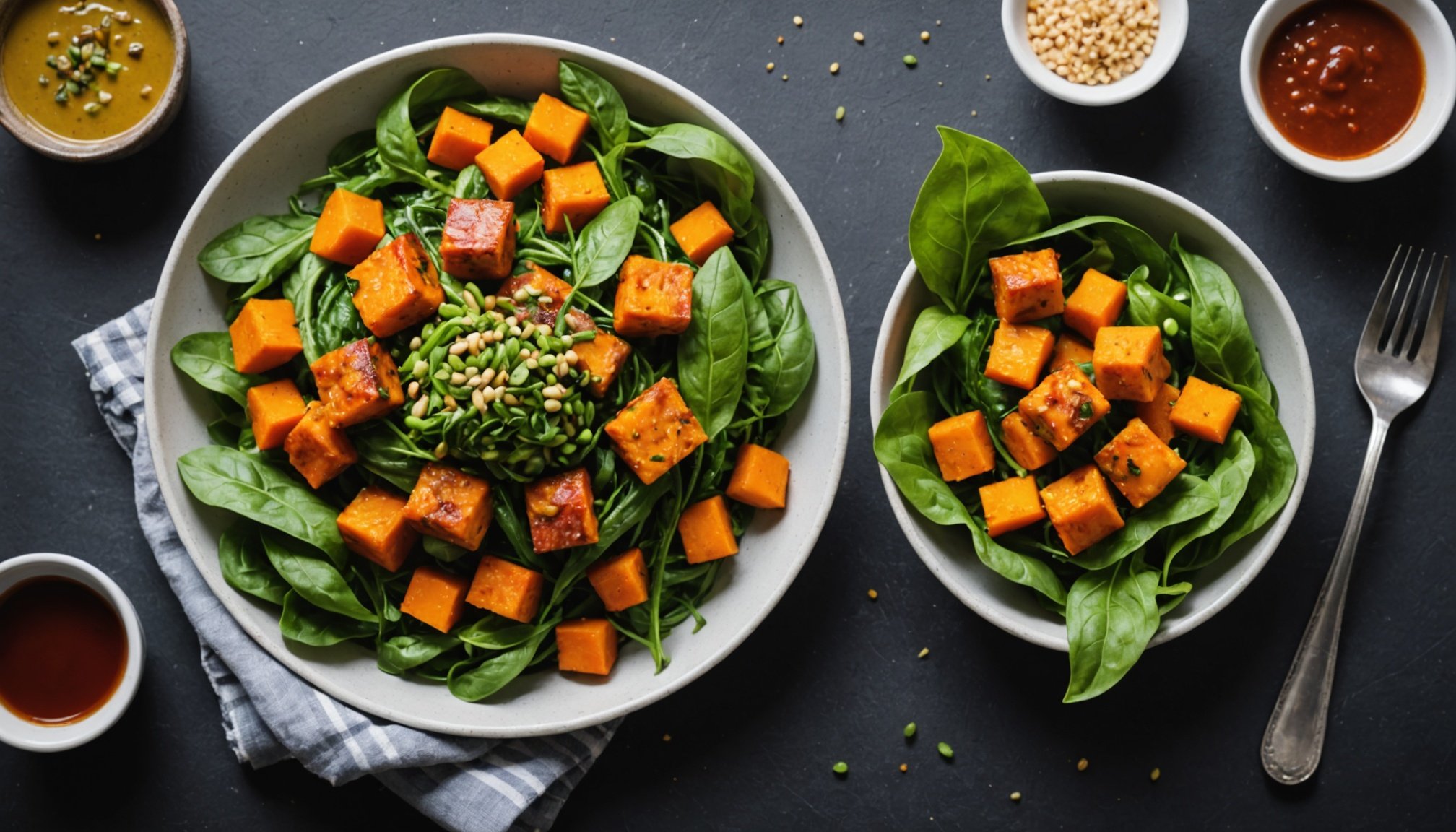Advanced Flavor Techniques for Vegan Dishes
Exploring flavor enhancement in vegan cooking can elevate your dishes to a new dimension. Effective techniques for layering flavors include combining different cooking methods like sautéing and roasting, which allows ingredients to release a variety of tastes over different stages of cooking. Utilizing umami-rich ingredients, such as nutritional yeast or tamari, can provide the savory depth often craved in plant-based cuisines. Incorporating umami not only intensifies flavors but also complements other ingredients beautifully.
Additionally, creative herb and spice combinations can transform simple ingredients. For example, pairing smoked paprika with cumin adds richness and warmth to roasted vegetables, while fresh coriander with lime juice brings brightness to stir-fries. Experimentation is key, as vegan cooking encourages innovation and the discovery of personal flavor preferences.
Also read : Essential Gadgets and Appliances for a Health-Focused Raw Food Restaurant Kitchen
Achieving a symphony of flavors in vegan dishes doesn’t rely on conventional animal-based products. Instead, by focusing on these vegan cooking techniques, chefs can masterfully craft meals that are as satisfying as they are wholesome. Remember, the goal is to create layers of taste that delight the palate and provide a memorable dining experience without animal ingredients.
Unique Ingredient Pairings
Delving into ingredient innovation can transform vegan dishes beyond the ordinary. Uncommon vegan pairings can redefine taste profiles, offering unexpected satisfaction to the palate. For instance, pairing chocolate with ginger adds a spicy dimension to sweet desserts, while beetroot combined with citrus surprises with its vibrant contrast.
Also read : Transform Your Bar Layout: Key Tactics to Optimize Space for Busy Events
Uncommon Flavor Enhancers
Exploring lesser-known plant-based ingredients can be a game-changer in flavor addition. Products like black garlic, known for its molasses-like richness, or miso paste with its deep umami quality, can elevate even the simplest meals. Surprising combinations, such as melon with jalapeño, work remarkably well by balancing sweetness with heat.
Seasonal Produce Utilization
Incorporating local and seasonal ingredients not only supports sustainability but ensures freshness and enhances taste. Seasonal delights like pumpkin in autumn or asparagus in spring bring distinct flavors and textures that enrich any recipe. Crafting innovative recipes that highlight the unique qualities of seasonal produce can make each meal a celebration of its time of year, drawing diners closer to the earth’s cycles. By embracing these techniques, chefs can continually refresh their offerings and keep guests intrigued with every change of season.
Mastering Vegan Sauces and Condiments
Crafting the perfect vegan sauces can significantly elevate the depth of any dish. Versatile plant-based sauces serve as the foundation that ties flavors together, enhancing both taste and texture. It’s crucial to focus on elements like texture and acidity. Achieving the right balance can transform a dish from mundane to memorable.
Using umami-rich flavor bases like mushrooms, soy sauce, or nutritional yeast can mimic the savory feel typically derived from animal products. These bases are ideal for creating broths and dressings that add complexity to your culinary repertoire. Incorporating elements like citrus or vinegar further introduces the necessary tang to invigorate the palate.
Consider recipes like a creamy cashew sauce or a zesty aioli. Both offer rich flavor profiles while maintaining a plant-based ethos. Texture is key; blending nuts or stirring in tahini can provide creaminess without dairy. Always remember that vegan cooking demands innovation. Employing these techniques not only diversifies your menu but also offers a satisfying exploration of taste. Through thoughtful preparation of sauces and condiments, chefs can create dishes that not only fulfil but deeply satisfy.
Innovative Cooking Methods
Vegan preparation techniques are evolving, with innovative cooking methods offering fresh ways to enhance flavors in plant-based dishes. Techniques such as sous vide and fermentation are becoming staples in vegan kitchens worldwide. Sous vide involves cooking vacuum-sealed ingredients in a controlled water bath, which preserves nutrients and enriches taste by maintaining consistent temperatures. Fermentation, on the other hand, introduces beneficial bacteria and develops complex flavors, making dishes like kimchi or kombucha surprisingly zesty.
Grilling and smoking can also add extraordinary depth to vegetable flavors. The charred nuances that come from grilling or smoking can transform simple veggies into a feast for the senses, creating taste experiences that are rich and satisfying. These traditional methods have been adapted, allowing chefs to offer profound taste profiles without animal-based ingredients.
Adapting age-old techniques for modern plant-based cuisine demands creativity and exploration. By tapping into these cooking methods, creative culinary professionals can push vegan dishes beyond conventional boundaries, providing meals that are not only innovative but also deeply flavourful and satisfying. These methods empower chefs to consistently surprise and delight their diners with rich, multi-dimensional plant-based offerings.
Menu Innovation for Vegan Offerings
Menu innovation in vegan cuisine is crucial as it keeps offerings fresh and engaging. By analyzing current trends, understanding what drives the vegan food movement helps chefs adapt and enhance their menu. One significant trend includes the incorporation of global flavors, showcasing diverse culinary techniques and heritage. This allows for a more comprehensive and exciting vegan menu design.
Trend Analysis in Vegan Cuisine
The surge in plant-based eating has opened opportunities for chefs to embrace global culinary traditions. It’s pivotal to understand these trends as they encourage innovations like incorporating spices and techniques from Asian, Middle Eastern, or Afro-Caribbean cuisines. Such strategies not only diversify the menu but also attract diners seeking novel experiences.
Signature Vegan Dishes
Developing signature vegan dishes that resonate with diners can set a restaurant apart. By drawing inspiration from successful case studies, such as eateries renowned for their vegan innovation, chefs can create standout offerings. Emphasizing unique flavor profiles and creative presentation ensures these dishes become memorable, defining the establishment’s culinary identity in the competitive vegan landscape.
Practical Tips for Executing Vegan Recipes
Executing vegan recipes can be a rewarding yet challenging endeavour. To start, effective kitchen organisation is fundamental. Keeping a well-organised workspace ensures a smoother cooking process, allowing for quick access to crucial ingredients like fresh herbs or spices that are often used in vegan cooking techniques.
Next, scaling recipes for high-volume service requires precision and preparation. Doubling ingredients might seem straightforward, but it necessitates understanding the impact on cooking times and temperatures. It’s essential to monitor layered flavours and adjust seasonings like umami-rich soy sauce for large batches to maintain consistent taste.
For complex vegan dishes, step-by-step guidance is beneficial. Break down recipes into clear, manageable steps, focusing on techniques such as creating sauces with optimal texture and acidity. This attention to detail ensures that each component of the dish is well-executed, contributing to the harmonious overall flavour.
Lastly, incorporate global flavours thoughtfully. By mastering spice blends inspired by various cuisines, chefs can offer unique and inviting vegan dishes. With practice and organization, preparing complex vegan meals becomes a methodical yet creative process, delighting diners with every bite.





